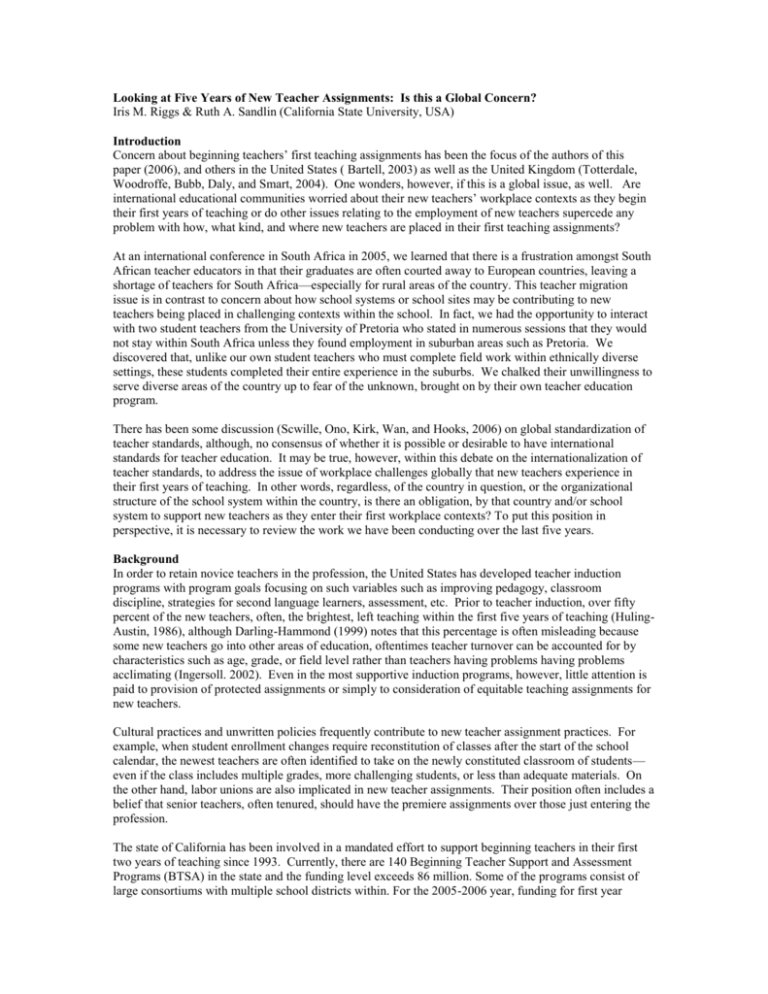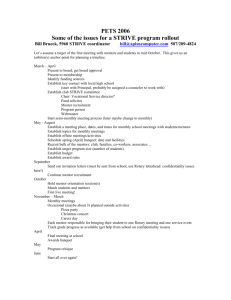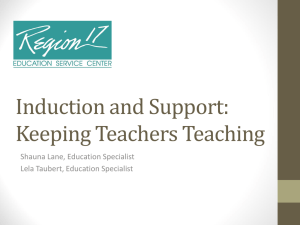New Teachers` Initial Teaching Assignments: Is this a
advertisement

Looking at Five Years of New Teacher Assignments: Is this a Global Concern? Iris M. Riggs & Ruth A. Sandlin (California State University, USA) Introduction Concern about beginning teachers’ first teaching assignments has been the focus of the authors of this paper (2006), and others in the United States ( Bartell, 2003) as well as the United Kingdom (Totterdale, Woodroffe, Bubb, Daly, and Smart, 2004). One wonders, however, if this is a global issue, as well. Are international educational communities worried about their new teachers’ workplace contexts as they begin their first years of teaching or do other issues relating to the employment of new teachers supercede any problem with how, what kind, and where new teachers are placed in their first teaching assignments? At an international conference in South Africa in 2005, we learned that there is a frustration amongst South African teacher educators in that their graduates are often courted away to European countries, leaving a shortage of teachers for South Africa—especially for rural areas of the country. This teacher migration issue is in contrast to concern about how school systems or school sites may be contributing to new teachers being placed in challenging contexts within the school. In fact, we had the opportunity to interact with two student teachers from the University of Pretoria who stated in numerous sessions that they would not stay within South Africa unless they found employment in suburban areas such as Pretoria. We discovered that, unlike our own student teachers who must complete field work within ethnically diverse settings, these students completed their entire experience in the suburbs. We chalked their unwillingness to serve diverse areas of the country up to fear of the unknown, brought on by their own teacher education program. There has been some discussion (Scwille, Ono, Kirk, Wan, and Hooks, 2006) on global standardization of teacher standards, although, no consensus of whether it is possible or desirable to have international standards for teacher education. It may be true, however, within this debate on the internationalization of teacher standards, to address the issue of workplace challenges globally that new teachers experience in their first years of teaching. In other words, regardless, of the country in question, or the organizational structure of the school system within the country, is there an obligation, by that country and/or school system to support new teachers as they enter their first workplace contexts? To put this position in perspective, it is necessary to review the work we have been conducting over the last five years. Background In order to retain novice teachers in the profession, the United States has developed teacher induction programs with program goals focusing on such variables such as improving pedagogy, classroom discipline, strategies for second language learners, assessment, etc. Prior to teacher induction, over fifty percent of the new teachers, often, the brightest, left teaching within the first five years of teaching (HulingAustin, 1986), although Darling-Hammond (1999) notes that this percentage is often misleading because some new teachers go into other areas of education, oftentimes teacher turnover can be accounted for by characteristics such as age, grade, or field level rather than teachers having problems having problems acclimating (Ingersoll. 2002). Even in the most supportive induction programs, however, little attention is paid to provision of protected assignments or simply to consideration of equitable teaching assignments for new teachers. Cultural practices and unwritten policies frequently contribute to new teacher assignment practices. For example, when student enrollment changes require reconstitution of classes after the start of the school calendar, the newest teachers are often identified to take on the newly constituted classroom of students— even if the class includes multiple grades, more challenging students, or less than adequate materials. On the other hand, labor unions are also implicated in new teacher assignments. Their position often includes a belief that senior teachers, often tenured, should have the premiere assignments over those just entering the profession. The state of California has been involved in a mandated effort to support beginning teachers in their first two years of teaching since 1993. Currently, there are 140 Beginning Teacher Support and Assessment Programs (BTSA) in the state and the funding level exceeds 86 million. Some of the programs consist of large consortiums with multiple school districts within. For the 2005-2006 year, funding for first year teachers was $3675 per teacher and second year teachers were funded at $2894 per teacher. Although, California uses multiple measures to assess the programs effectiveness, a recent analysis suggests that teachers who were part of BTSA were 26 percent more likely to stay in teaching. The authors of this paper, worked continuously since 1993 in the training of mentor teachers and beginning teachers within a California BTSA program. During that time we began to be very interested in the stories that mentors told us about the workplace issues and challenges that their new teachers faced in their first years of teaching. We heard instances, where new teachers were assigned to teach on stages in cafeterias, or had no permanent classroom space within a school day. One mentor described a new teacher who had her classroom in the kindergarten in the morning and had to move her children to the school library in the afternoon. Other examples, included new teachers who were given the most disruptive students in the school or who were assigned to teach classes in content areas for which they were not certified. It is important, to keep in mind, that these stories were coming from mentors who were working in a structured new teacher induction program where state legislation requires that school districts are to take novice status into consideration and they are to provide additional time and resources to teachers assigned to more challenging settings. Method The program in question, is a part of a California-mandated effort to support beginning teachers in their first two years of teaching. This program is located in Southern California and serves a geographically diverse region with a total number of 40,506 square miles or 65,186 kilometers. Within its first year, this program served 190 beginning teachers in 17 school districts through the use of 55 mentors. The program has received state funding continuously since 1993-1994. Within the 2004-2005 years, 1423 beginning teachers and 583 mentors from 61 school districts were served, respectively. The California Standards for the Teaching profession (CSTP), published in 1997, provide the theoretical underpinnings for the process of support and assessment of new teachers. The California Formative Assessment System for Teachers (CFASST), designed by Educational Testing Services in 1998, is utilized to guide support of new teachers within the program. The state also developed specific standards to guide induction programs. These standards for induction must be met by all districts or county offices of education that implement induction. While the programs do not experience full accreditation, in order to receive their state funding, they must go through an initial paper review and informal and formal reviews to verify that they meet the induction standards. While a specific standard for appropriate assignment of new teachers does not exist within the standards, there is reference to new teacher assignments within multiple standards that equates to the following directives: Reduce the number of challenges faced by our new teachers in comparison to veterans. Provide challenge-specific support when challenges cannot be avoided. As a consortium without individual power to make policy for the 61 school districts that are part of our induction program, those goals are quite lofty. We decided to utilize the premise of knowledge breeds change, which had previously worked quite successfully for us. Within the prior situation, we had provided each district with its mentor teachers’ time allotment charts in comparison with the aggregate for the project in the hopes that districts which were overloading their mentors would select to appropriately adjust assignments to align with project averages. We also provided the same information to the mentor teachers, who then might use the knowledge to negotiate their workload through their unions and administration. Since this strategy had successfully garnered more appropriate workloads for our mentors, a similar strategy was planned in regards to challenges for new teachers as described below. Data Sources Again, since our induction program is a consortium of 61 school districts with a county office of education as lead agency, the means for lowering and remediating challenges had to take an indirect path. We pursued the following actions for each of 5 years: Required that mentors reflect on their own new teachers’ specific challenges. Measured the mentors’ ratings of their novice teachers’ assignments as compared to veteran teachers at the same school site. Reported the project aggregate data to the mentors by type of challenge. Reported the project aggregate data to district liaisons in addition to his/her own district results. Acquainted both mentors and district liaisons with the induction standards that relate to appropriate assignment of new teachers and to appropriate support for new teachers with challenges. Held discussions with mentors related to their novices’ challenges and how to provide additional support for those in more challenging settings. Measurement of Challenges In order to investigate the placements of the novice teachers, a decision was made to survey their assigned mentors. The novices themselves might well have biased opinions or perhaps be too novice to be adequate judges of what constitutes challenges that are greater than those of other more experienced teachers. Mentors were seen as having more understanding of a “typical” placement within their school or district. Mentors have been surveyed at approximately the midpoint of the academic year in order to provide them with ample time to have developed knowledge of their new teachers’ settings. During training sessions, mentors were asked to identify the contexts of each of their mentee’s classrooms. (Mentors could be serving from one to four novices.) Survey instruments asked mentor teachers to rate whether or not any of the eleven challenging aspects were present in the teaching assignment of their supervisees to a greater degree than that of experienced teachers at the same site. The following challenges were included using a Likert scale: Teaching out of content area preparation Teaching out of grade level preparation Larger number of different types of preparation than experienced teachers at same site Combination grade levels Overflow classroom (taking students from over-filled classrooms) No real classroom (on stage, in hallway…) Roving teacher (moves classroom periodically) Classroom doesn’t basic materials &/or resources (no lab or no texts while similar teachers have them). Higher percentage of challenging students than most experienced teachers at the same site Larger number of students than most experienced teachers at the same site Assignment has been changed more than that of most experienced teachers Other If the mentor teachers strongly agreed the challenge was present, a value of five was assigned. If they strongly disagreed that the challenge was present, a value of one was marked. Two additional options were provided, and raters were asked to identify and rate any challenges not specifically described in the survey. A total “challenge” score was computed by calculating an average of the one-to-five responses given to the eleven challenge items. Results Over the last five years, the number of mentor teachers responding to surveys has risen from 475 new teachers to 1142. The percentage of challenges faced by new teachers is portrayed in the table below: Year 00-01 01-02 02-03 03-04 04-05 % with 0 Challenges 40 43 57 47 48 % with 1 Challenge 23 20 15 21 20 % with 2 Challenges 14 11 10 13 11 % with 3 or more Challenges 23 26 18 19 21 State induction data from 2004-2005 also indicated that challenges exist for the states’ new teachers with 43.7% of mentor teachers (n=3642) reporting that their beginning teachers had challenging assignments. Percentages for each specific challenge are reported by year in the following graph: Clearly, the yearly results follow a similar pattern. While random types of challenges may have increased or decreased periodically, there appears to be no trend. Analysis Challenges’ percentages rose or decreased with no apparent pattern throughout the five years. Exceptions included teaching within an overflow classroom which remained quite stable until the last year which saw a decrease of 5% points. The percentage of teachers experiencing an assignment change also stayed quite stable throughout the years (7%-8%). Teaching without a real classroom was consistently reported as the least experienced challenge (3%-6%), while having more challenging students was always reported as the most experienced challenge (23%-30%). Conclusions Given the efforts this induction program has made over time to reduce challenges faced by its new teachers, this study’s results are discouraging. Knowledge of standards for appropriate assignment of new teachers, knowledge of district challenges in comparison to the project data, and knowledge of the difficulties that such challenges cause for new teachers have not been able to influence a clear decline in challenges for teachers within this project. The explanation may relate to who gained access to the knowledge. The district liaisons and mentors were the only groups to receive the data reports. District liaisons within this project are typically administrators or teachers-on-assignment with responsibility for induction. They are not personnel directors or administrators with responsibility for placements of new teachers. The mentor teachers, while often empathetic with their new teachers’ situations and also impacted by the amount of support needed by teachers under the duress of challenges, still are not the teachers directly experiencing the challenges. Thus, the receivers of the knowledge within this study were quite different than those within our previous efforts to reduce mentor workload. Within this prior intervention, knowledge was provided directly to the mentors experiencing the inequities and to the district liaisons, who, in this case, had more influence over mentor workload. This project utilized the same audiences to receive the knowledge, and omitted the groups with most direct concern and with the most power to utilize the knowledge—the novice teachers and the administrators who make the assignments. Still, one has to wonder if novice teachers would pursue the inequities between themselves and veteran teachers while still in the tentative role of new, untenured professionals. Perhaps teacher unions might be more likely to make use of such knowledge in negotiation of teacher contracts. Yet, veteran teachers, and therefore teacher unions, are often accepting of the more difficult contexts that new teachers face. The profession has evolved with no protection for the novice, no plan for advancement based upon increasingly challenging assignments. While some veterans step forward to take the most challenging students when a new classroom is established midyear, for example, it is only through their charity that such actions take place. There are no employment practices that protect new teachers from overload. In fact, teachers’ unions most likely have negotiated contracts to protect teachers with experience and expertise from being assigned to the more complicated assignments. Totterdell, Bubb, and Earley (2005) argue that “rogue” principals may sabotage new teachers at their school sites out of ignorance, misunderstanding, or incompetence or rather it is a deliberate flouting of the induction regulations because they do not value the induction program goals or structure. It may be that we need to focus specifically within the schools in our program to analyze why certain schools may have more context challenges compared to others. When one considers these results in connection with global issues of teacher retention and teacher migration, it appears even more critical that teachers themselves take control of their profession’s process for induction of new teachers. When teacher assignments are a negotiated issue, it may be that new teachers will find themselves within reasonable settings only when teachers and their unions will no longer stand for a practice that appears to be contrary to those of other professions. Within countries with little teacher preparation for challenging contexts, the resulting teacher migration or teacher flight might be even more problematic. Should preservice teachers experience only the suburban field placements, for example, they logically would be resistant to securing employment within other rural or urban settings. When they do, if the profession’s norm is to assign the novices the most challenging students or to allow them to be the teachers who are short of materials, how long will the new teachers be willing to face the challenge? The answers to this complex issue may relate to both knowledge and policy: In order to know how challenging contexts relate to teacher migration or low teacher retention, districts must have data on percentages of challenges and the types of challenges, in addition to migration and retention rates. The culture of denial related to how the teaching profession treats its newest members cannot continue with knowledge of its practices. Teachers must reflect on their professions’ induction of teachers in comparison of to induction within other professions. Administrators with responsibility for employment and assignments must also analyze their practices in light of specific data. Policies need to result from knowledge of practice to appropriately place new teachers and to support them when challenging assignments are unavoidable. References Bartell, C. (2004). Cultivating High Quality Teaching Through Induction And Mentoring. Corwin Press: CA. Darling-Hammond Darling-Hammond, L. (1999). Solving the dilemma of teacher supply, demand, and standards: How can we ensure a competent, caring, and qualified teacher for every child. New York: National Commission on Teaching & America’s Future. Huling –Austen, L. (1986). Assisting the Beginning Teacher. Restin, VA: Association of Curriculum and Development. Ingersoll. R.M. (2002). The teacher shortage: A Case of Wrong Diagnosis and Wrong Prescription. Bulletin, 86, ( 631), 1-13. Riggs, I.M. and Sandlin, R.A. (2006). Professional development of U.S. mentors A beginning teacher program: Can we impact veteran teachers’ self-perceived teacher competence? In Globalization, Standards and Profession: Teacher Educations in Times of Change (Eds.) Tony Townshend & Richard Bates. Springer-Kluwer. Totterdell, M., Woodroffe, L., Bubb, S., Daly,C., and Smart, T. (2004). What are the effects of induction on newly qualified teachers in relation to their Professional practice? A systematic review of research literature on Induction. EPPI-Centre, Institute of Education, University of London. Totterdell, M., Bubb, S., and Earley, P. (2005). “Rogue” school leaders and the induction of new teachers in England. Oxford Review of Education, 31(2), 255-272.





